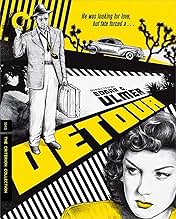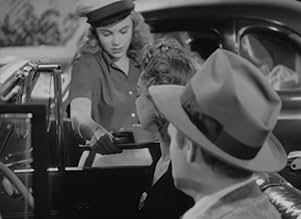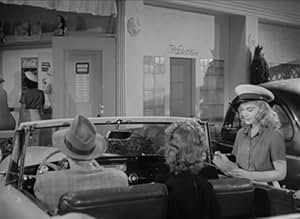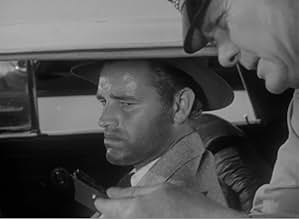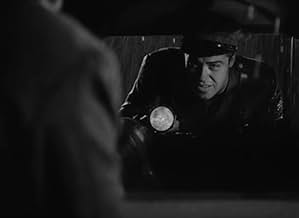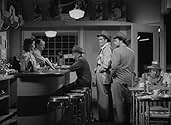IMDb-BEWERTUNG
7,3/10
20.966
IHRE BEWERTUNG
Zufällige Ereignisse verwickeln den Anhalter Al Roberts in ein immer enger werdendes Netz von Film-noir-Problemen.Zufällige Ereignisse verwickeln den Anhalter Al Roberts in ein immer enger werdendes Netz von Film-noir-Problemen.Zufällige Ereignisse verwickeln den Anhalter Al Roberts in ein immer enger werdendes Netz von Film-noir-Problemen.
- Auszeichnungen
- 1 wins total
Don Brodie
- Used Car Salesman
- (Nicht genannt)
Roger Clark
- Cop
- (Nicht genannt)
Eddie Hall
- Tony - Used-Car Lot Mechanic Inspecting Car
- (Nicht genannt)
Harry Mayo
- Nightclub Patron
- (Nicht genannt)
Harry Strang
- California Border Patrolman
- (Nicht genannt)
Empfohlene Bewertungen
When I got my first VCR in 1985, the two movies I immediately rented were "Baby Doll" and "Detour." I have revisited the former many times but it's been 20 years since I saw "Detour." I like it even better.
It moves in a seamless manner. The narrator is drawn as we watch into further and further degradation.
The movie has a beautiful look. I'm sure it's a cliché to note this but it resembles a Hopper painting. It also bears the trademarks of Edgar Ulmer's movies: Literate dialogue and classical movie, no matter how low the budget.
Tom Neal is a mournful, appealing protagonist. He's weak, not really bad. Ann Savage, of course, is terrifying as Vera, the hitchhiker from everyone's worst nightmare.
Al's descent from blonde soubrette Sue to consumptive, murderous Vera is terrifying. Yet, though it passes by us quickly, it is fully believable.
"Detour" is a true work of art.
It moves in a seamless manner. The narrator is drawn as we watch into further and further degradation.
The movie has a beautiful look. I'm sure it's a cliché to note this but it resembles a Hopper painting. It also bears the trademarks of Edgar Ulmer's movies: Literate dialogue and classical movie, no matter how low the budget.
Tom Neal is a mournful, appealing protagonist. He's weak, not really bad. Ann Savage, of course, is terrifying as Vera, the hitchhiker from everyone's worst nightmare.
Al's descent from blonde soubrette Sue to consumptive, murderous Vera is terrifying. Yet, though it passes by us quickly, it is fully believable.
"Detour" is a true work of art.
It's a tribute to Edgar Ulmer that "Detour", made for about thirty thousand dollars, still keeps an interest with new fans who discover it. According to some comments, "Detour" has not been seen in this country in quite a while, but we recall the first time we saw it when it was presented at New York's Film Forum as part of a Film Noir festival in the late eighties. The copy shown recently on TCM has a poor quality, while the print we saw at Film Forum was in better condition.
What makes "Detour" a must see, is the clever way its narrative unfolds on the screen. Al and Sue are seen first in the small bistro he plays the piano and she sings, in Manhattan. Sue sings a happy rendition of "I Can't Believe You're in Love with Me", and Al shows he can improvise on a theme by Chopin as he jazzes it up. When Sue decides to pack it and move to L.A., Tom promises he'll follow. The tragic mistake he makes is to intent crossing the country hitchhiking. Even in the forties, it's a miracle he made it alive!
In Arizona Al meets the kind Charles Haskell, who happens to be going all the way to L.A. and offers him a ride. The two men develop an easy friendship until the point when Haskell dies of an apparent heart attack. Al disposes of the body and keeps going, assuming now, Haskell's persona. At the nearest gas station he sees a pretty woman, Vera, who appears is hitchhiking, and offers her a ride. This will prove to be his biggest mistake.
Vera turned out to be Al's worst nightmare. She knows Al is not Haskell since she, herself, knows the man. Al ends up a virtual prisoner hiding in the apartment they have rented in Hollywood. He can't escape. When Vera realizes there's a lot of money to be made by having Al pretend to impersonate the dead Haskell, he refuses. She threatens to call the police and he is left on the other room pulling the telephone cord...
The film works because all the elements are in place in this satisfying 67 minutes work and because of the great performances Mr. Ulmer got out of Tom Neal and Ann Savage. Edmund MacDonald and Claudia Drake played Haskell and Sue.
"Detour" was shot in two sets and it shows. It's a small film that doesn't pretend what it's not, and that's basically why audiences seem to like it as it's discovered.
What makes "Detour" a must see, is the clever way its narrative unfolds on the screen. Al and Sue are seen first in the small bistro he plays the piano and she sings, in Manhattan. Sue sings a happy rendition of "I Can't Believe You're in Love with Me", and Al shows he can improvise on a theme by Chopin as he jazzes it up. When Sue decides to pack it and move to L.A., Tom promises he'll follow. The tragic mistake he makes is to intent crossing the country hitchhiking. Even in the forties, it's a miracle he made it alive!
In Arizona Al meets the kind Charles Haskell, who happens to be going all the way to L.A. and offers him a ride. The two men develop an easy friendship until the point when Haskell dies of an apparent heart attack. Al disposes of the body and keeps going, assuming now, Haskell's persona. At the nearest gas station he sees a pretty woman, Vera, who appears is hitchhiking, and offers her a ride. This will prove to be his biggest mistake.
Vera turned out to be Al's worst nightmare. She knows Al is not Haskell since she, herself, knows the man. Al ends up a virtual prisoner hiding in the apartment they have rented in Hollywood. He can't escape. When Vera realizes there's a lot of money to be made by having Al pretend to impersonate the dead Haskell, he refuses. She threatens to call the police and he is left on the other room pulling the telephone cord...
The film works because all the elements are in place in this satisfying 67 minutes work and because of the great performances Mr. Ulmer got out of Tom Neal and Ann Savage. Edmund MacDonald and Claudia Drake played Haskell and Sue.
"Detour" was shot in two sets and it shows. It's a small film that doesn't pretend what it's not, and that's basically why audiences seem to like it as it's discovered.
When the pianist Al Roberts gets tired of being miserable and missing his girlfriend who traveled across the country to seek her fortune in Hollywood, he decides to leave New York behind. He has no money to pay for the trip from one coast to the other, so he decides to hitchhike, something that proves to be his downfall. A man who picked him up dies during the journey and Al panics when he pessimistically expects to be accused of the death. He steals not only the man's car, but also his identity and stows away the corpse in a ditch. He then decides to pick up a hitchhiker named Vera, but he will soon regret it because she seems to know his dark secret and will not hesitate to take advantage of it.
The story feels more than a little strained on more than one occasion. It's hard not to fall in love the hopelessness that constitutes Detour. A low-budget thriller directed by Edgar G. Ulmer. Sure, it's an extremely simple B-movie, but it is packed full of interesting quotes, friendly cynicism, pitch black darkness and at least as much rain. It is insanely entertaining to see Vera and Al throw sharp barbs at each other while the tones are so miserable that they find it hard to laugh at them.
With a playing time of over 70 minutes says Detour goodbye long before it has time to start to feel tiring.
The story feels more than a little strained on more than one occasion. It's hard not to fall in love the hopelessness that constitutes Detour. A low-budget thriller directed by Edgar G. Ulmer. Sure, it's an extremely simple B-movie, but it is packed full of interesting quotes, friendly cynicism, pitch black darkness and at least as much rain. It is insanely entertaining to see Vera and Al throw sharp barbs at each other while the tones are so miserable that they find it hard to laugh at them.
With a playing time of over 70 minutes says Detour goodbye long before it has time to start to feel tiring.
Is Detour just a bad dream? Or a masochistic reverie dredged up out of the sumps of self-loathing? Long before setting out on the road trip that took such a disastrous turn, Tom Neal was a picky eater at life's banquet. Pounding the ivories in a Manhattan nitery, he sulks that his talent goes unappreciated (when a drunk tips him a ten-spot, it's 'a piece of paper crawling with germs'). He sabotages his rapturous renditions of Chopin and Brahms waltzes with a left-handed boogie-woogie beat. When his girl, the club's shantoozie, tells him that he'll make it to Carnegie Hall 'someday,' he snaps back, 'Sure, as a janitor. Maybe I'll make my debut in the basement,' and 'Yeah, someday if I don't get arthritis first.' Neal's lousy with what we now call issues.
When his fiancée heads to Los Angeles to try for the lush life, he lets her go, then, suddenly lonesome, decides to hitch out to the coast. In Arizona, he thumbs a ride from a pill-popping driver (Edmund McDonald) with scratches on his wrist from tussling with a 'wild animal' a woman he had picked up in Louisiana. When Neal takes over the wheel during a rainstorm, McDonald up and dies and conks his head on a rock as he slumps out the passenger door. Looks bad. Since he casts himself as eternal victim, Neal, though blameless, guiltily drags the body into the desert and assumes its identity (along with car and wallet). Later, at a gas station, he offers a lift to another thumb-jockey (Ann Savage), even though she looks like she 'just got thrown off the crummiest freight train in the world.' (Does the phrase 'self-destructive' strike a familiar note?) In fact, she's none other than the beast who sank her claws into the deceased and plans to make an even bigger feast out of Neal....
The stubble on Neal's unshaved chin can't disguise his pouty, pretty-boy looks, and he proves just right as this callow, ill-starred loser (a better actor would have added superfluous dimensions). If he and his self-absorbed predicament start to wear a little thin, it ceases to matter when Savage arrives halfway through to give a performance that beggars all description. Owing either to Ulmer's or her own genius (or to exigent production values), her hard face stays stripped of glamor when she does slap on the war paint, the effect is primitive, alarming, with eyebrows that looked slashed on with a stiletto under an unkempt riot of hair. She starts off slowly, until, supposedly dozing in the shotgun seat, her eyes fly open to size up and devour Neal. It's the most terrifying instant in Detour. From then on in, she's all shrew all the time, drunk or sober, intimidating or seductively manipulative. Thus Savage's Vera entered film history as the hardest-boiled of its femmes fatales. And Neal never knew what hit him.
Insolently original a classic in a class by itself Detour is by no stretch of the imagination a conventional masterpiece (if masterpieces can be counted as conventional). It shows evidence of starting out to be something a longer, more fully developed movie quite different from what it ended up . Groundwork gets laid for developments that never come to pass. What seems to be intended as the plot's centerpiece a scheme to pass Neal off as McDonald, the lost scion of a wealthy family comes to nothing. As does Savage's ominous cough, a clue to her subsequent indifference ('I'm on my way anyhow') to that 'perfume Arizona hands out free to murderers.'
Somewhere along the way, Detour ran out of time, or money, or film stock, and was cobbled together out of footage already in the can, with the aid of peculiar voice-overs (in the last-ditch manner of The Magnificent Ambersons or My Son John). Against all odds, it still worked, and remains one of the best known and most unforgettable titles in the film noir canon, a stunningly effective piece of work that manages to encapsulate, in 67 minutes, all the inchoate angst that informs the cycle. It may have been an accident, but it's the kind of accident you can't peel your eyes off of.
When the noir cycle began to coalesce in the early 1940s, it looked like it was going to take the high road of starry, big-budget prestige productions (The Maltese Falcon, I Wake Up Screaming, The Glass Key, Laura, Double Indemnity, Mildred Pierce). Edgar G. Ulmer's Detour took the low road. A Poverty-Row production empty of box-office names, it was shot on a few cheap sets in a matter of days. But it sweated off a raw power that other alert film-makers working on the fringes of the industry were quick to emulate; the next few years would see Fall Guy, The Guilty, Suspense, Violence, I Wouldn't Be In Your Shoes, Decoy (the pick, along with Detour, of this particular litter) all done with wannabes or has-beens in cast and crew, visually often ugly (the murky lighting more a matter of necessity than moody esthetic choice). It was often inspired movie-making on the most frayed of shoestring budgets.
And yet, with a few exceptions, this second-feature slot was the niche into which film noir would settle until it ran its course in the late 1950s. Which raises a question: Without Detour paving the way for quick-and-dirty, sensational fodder to fill up double bills B-movies that the suits in the front offices didn't much care about and so paid little attention to would the noir cycle have been but a brief flash in the pan? Would it have stayed the passion only of a handful of French cineastes? Would it have amounted to a cycle at all? The debt owed to Detour may be greater than acknowledged.
When his fiancée heads to Los Angeles to try for the lush life, he lets her go, then, suddenly lonesome, decides to hitch out to the coast. In Arizona, he thumbs a ride from a pill-popping driver (Edmund McDonald) with scratches on his wrist from tussling with a 'wild animal' a woman he had picked up in Louisiana. When Neal takes over the wheel during a rainstorm, McDonald up and dies and conks his head on a rock as he slumps out the passenger door. Looks bad. Since he casts himself as eternal victim, Neal, though blameless, guiltily drags the body into the desert and assumes its identity (along with car and wallet). Later, at a gas station, he offers a lift to another thumb-jockey (Ann Savage), even though she looks like she 'just got thrown off the crummiest freight train in the world.' (Does the phrase 'self-destructive' strike a familiar note?) In fact, she's none other than the beast who sank her claws into the deceased and plans to make an even bigger feast out of Neal....
The stubble on Neal's unshaved chin can't disguise his pouty, pretty-boy looks, and he proves just right as this callow, ill-starred loser (a better actor would have added superfluous dimensions). If he and his self-absorbed predicament start to wear a little thin, it ceases to matter when Savage arrives halfway through to give a performance that beggars all description. Owing either to Ulmer's or her own genius (or to exigent production values), her hard face stays stripped of glamor when she does slap on the war paint, the effect is primitive, alarming, with eyebrows that looked slashed on with a stiletto under an unkempt riot of hair. She starts off slowly, until, supposedly dozing in the shotgun seat, her eyes fly open to size up and devour Neal. It's the most terrifying instant in Detour. From then on in, she's all shrew all the time, drunk or sober, intimidating or seductively manipulative. Thus Savage's Vera entered film history as the hardest-boiled of its femmes fatales. And Neal never knew what hit him.
Insolently original a classic in a class by itself Detour is by no stretch of the imagination a conventional masterpiece (if masterpieces can be counted as conventional). It shows evidence of starting out to be something a longer, more fully developed movie quite different from what it ended up . Groundwork gets laid for developments that never come to pass. What seems to be intended as the plot's centerpiece a scheme to pass Neal off as McDonald, the lost scion of a wealthy family comes to nothing. As does Savage's ominous cough, a clue to her subsequent indifference ('I'm on my way anyhow') to that 'perfume Arizona hands out free to murderers.'
Somewhere along the way, Detour ran out of time, or money, or film stock, and was cobbled together out of footage already in the can, with the aid of peculiar voice-overs (in the last-ditch manner of The Magnificent Ambersons or My Son John). Against all odds, it still worked, and remains one of the best known and most unforgettable titles in the film noir canon, a stunningly effective piece of work that manages to encapsulate, in 67 minutes, all the inchoate angst that informs the cycle. It may have been an accident, but it's the kind of accident you can't peel your eyes off of.
When the noir cycle began to coalesce in the early 1940s, it looked like it was going to take the high road of starry, big-budget prestige productions (The Maltese Falcon, I Wake Up Screaming, The Glass Key, Laura, Double Indemnity, Mildred Pierce). Edgar G. Ulmer's Detour took the low road. A Poverty-Row production empty of box-office names, it was shot on a few cheap sets in a matter of days. But it sweated off a raw power that other alert film-makers working on the fringes of the industry were quick to emulate; the next few years would see Fall Guy, The Guilty, Suspense, Violence, I Wouldn't Be In Your Shoes, Decoy (the pick, along with Detour, of this particular litter) all done with wannabes or has-beens in cast and crew, visually often ugly (the murky lighting more a matter of necessity than moody esthetic choice). It was often inspired movie-making on the most frayed of shoestring budgets.
And yet, with a few exceptions, this second-feature slot was the niche into which film noir would settle until it ran its course in the late 1950s. Which raises a question: Without Detour paving the way for quick-and-dirty, sensational fodder to fill up double bills B-movies that the suits in the front offices didn't much care about and so paid little attention to would the noir cycle have been but a brief flash in the pan? Would it have stayed the passion only of a handful of French cineastes? Would it have amounted to a cycle at all? The debt owed to Detour may be greater than acknowledged.
I'm not as fond of DETOUR as some of the other reviewers on here, purely because I found it an entirely depressing viewing experience. It's one of the darkest film noirs out there, leaden with a dreadful atmosphere throughout, full of foreboding, darkness, and misery. And I guess those are the reasons why it's so well remembered.
The film is directed by THE BLACK CAT director Edgar G. Ulmer in much the same way he would direct one of his horror pictures. Tom Neal makes for a rather unlikeable hero, trying desperate to hitch-hike from one end of the country to the other and coming unstuck when he falls in with a seemingly friendly driver. He takes a chance and thinks he's made it when in fact he's just about to meet Ann Savage's Vera.
Savage is the stand-out feature of this film and I hated every element of her angry, vengeful, selfish character. She's the worst femme fatale I've ever seen, a noxious character utterly devoid of redeeming features, to the degree that I found the movie hard to watch whenever she was around (which is most of the time). I admit that I thought the climax was excellent given what's come previously, although the only thing I came away from this feeling was relief, relief that it was over.
The film is directed by THE BLACK CAT director Edgar G. Ulmer in much the same way he would direct one of his horror pictures. Tom Neal makes for a rather unlikeable hero, trying desperate to hitch-hike from one end of the country to the other and coming unstuck when he falls in with a seemingly friendly driver. He takes a chance and thinks he's made it when in fact he's just about to meet Ann Savage's Vera.
Savage is the stand-out feature of this film and I hated every element of her angry, vengeful, selfish character. She's the worst femme fatale I've ever seen, a noxious character utterly devoid of redeeming features, to the degree that I found the movie hard to watch whenever she was around (which is most of the time). I admit that I thought the climax was excellent given what's come previously, although the only thing I came away from this feeling was relief, relief that it was over.
Wusstest du schon
- WissenswertesWhile the crew was setting up to film a hitchhiking scene, a passing car tried to pick up Ann Savage (made up to look dirty and disheveled), causing the crew to break out laughing.
- PatzerIn the first shots of Al hitchhiking, the film is reversed. The cars are driving on the wrong side of the highway and the drivers sitting behind the wheel are sitting on the right side of their vehicles.
- Zitate
Al Roberts: Money. You know what that is, the stuff you never have enough of. Little green things with George Washington's picture that men slave for, commit crimes for, die for. It's the stuff that has caused more trouble in the world than anything else we ever invented, simply because there's too little of it.
- VerbindungenEdited into Michael Jackson's This Is It (2009)
- SoundtracksI Can't Believe That You're in Love with Me
(uncredited)
Written by Jimmy McHugh and Clarence Gaskill
Performed by Claudia Drake
Played often in the score
Top-Auswahl
Melde dich zum Bewerten an und greife auf die Watchlist für personalisierte Empfehlungen zu.
Details
- Erscheinungsdatum
- Herkunftsland
- Offizielle Standorte
- Sprache
- Auch bekannt als
- Detour
- Drehorte
- Virginia Street, Reno, Nevada, USA(In rear projection shot in opening scene, the Reno Arch is seen through the car's rear window.)
- Produktionsfirma
- Weitere beteiligte Unternehmen bei IMDbPro anzeigen
Box Office
- Budget
- 30.000 $ (geschätzt)
- Bruttoertrag in den USA und Kanada
- 16.172 $
- Eröffnungswochenende in den USA und in Kanada
- 5.127 $
- 2. Dez. 2018
- Weltweiter Bruttoertrag
- 16.172 $
- Laufzeit1 Stunde 6 Minuten
- Farbe
- Seitenverhältnis
- 1.37 : 1
Zu dieser Seite beitragen
Bearbeitung vorschlagen oder fehlenden Inhalt hinzufügen


![Trailer [OV] ansehen](https://m.media-amazon.com/images/M/MV5BZGEyYTUwNDQtN2ZjZi00YmY2LWE2ZjUtOTY3NjQ3NDQ0Zjg3XkEyXkFqcGdeQXRyYW5zY29kZS13b3JrZmxvdw@@._V1_QL75_UX500_CR0)
